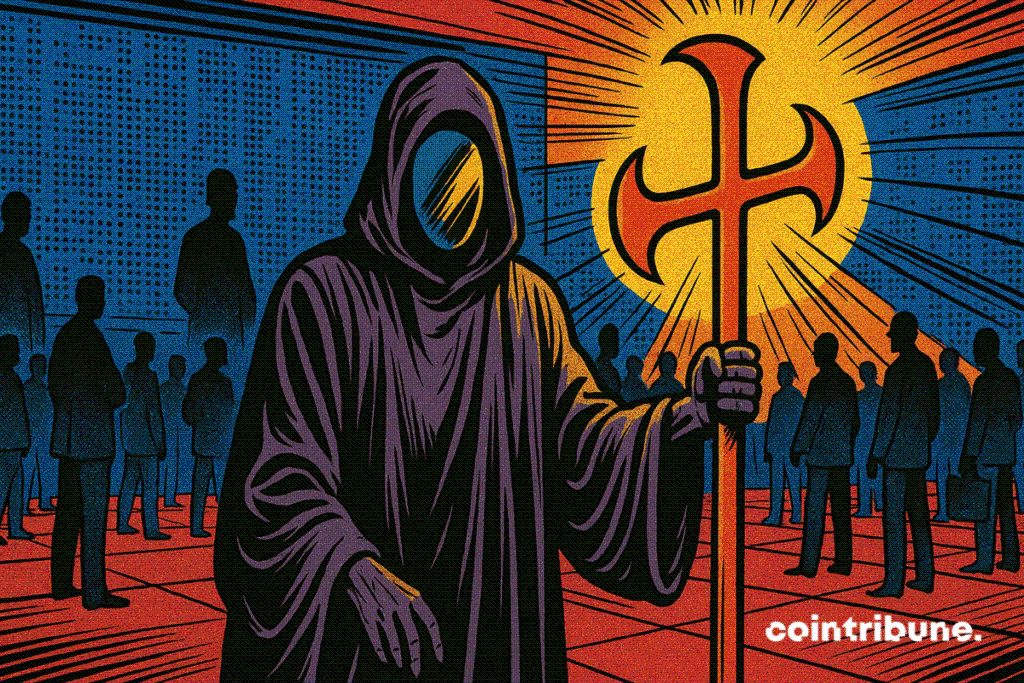Technical Pressure Builds As Bitcoin Nears Bearish Signal
As tension rises in the market, Bitcoin is about to cross a critical technical threshold : the “death cross”. This signal, feared by traders, occurs at a pivotal moment, at the intersection of a 25 % correction and an uncertain macroeconomic climate. While some see it as a classic bearish indicator, others recall it coincided with market lows. In this context, certainties waver, and each candlestick becomes a test for investor morale.

In brief
- Bitcoin is approaching a “death cross,” a bearish technical signal feared by both traditional and crypto investors.
- Despite its negative reputation, previous “death crosses” observed since 2023 have all coincided with local lows marking rebounds.
- The market has corrected by 25 % since its October peak, bringing BTC below its annual entry price of $93,507.
- The end of the US government shutdown, far from calming markets, triggered a new wave of decline, similar to a previous cycle in 2019.
The death cross signal : bearish indicator or turning point ?
Just a month after reaching a historic high above $126,000 , BTC has dropped nearly 25 %, temporarily wiping out all of its gains since the start of the year.
Data from Glassnode reveal that short and long-term trend indicators are about to cross downward, a phenomenon known as a “death cross”. This configuration, where the 50-day moving average (MA50) falls below the 200-day moving average (MA200), is generally seen as a bearish signal.
Bitcoin’s 50-day moving average at $110,669 is now about to cross below the 200-day moving average at $110,459. This dynamic is often feared as it reflects weakening short-term momentum against the underlying trend.
However, historical data from the past two years challenges this pessimistic reading. Since the start of the 2023 bull cycle, each occurrence of a death cross has marked a local bottom rather than a prolonged collapse. Here are the previous noted cases :
- September 2023 : the death cross coincided with a technical floor around $25,000 ;
- August 2024 : amid the yen carry trade crisis, Bitcoin bounced back after hitting $49,000 ;
- April 2025 : in a context of uncertainties related to Trump’s tariff policies, BTC briefly fell below $75,000 before rising again ;
- November 2025 : the Bitcoin price flirts with $94,000, and some analysts already see the beginnings of a new rebound just before the expected crossover.
This fourth crossover could once again play the role of a “bull trap” rather than a harbinger of a crash.
The fragile balance of the market
The current situation is not just a technical reading. The macroeconomic context acts as a catalyst for this volatility.
The end of the US government shutdown , which occurred on November 12 after 43 days of halt, paradoxically triggered a 10 % drop in BTC within a few days. This type of reaction had already been observed in January 2019 when Bitcoin declined by 9 % in the five days following the resumption of government activities.
Meanwhile, another factor weighs on the upward momentum : profit-taking behaviors among whales. It is not a panic movement but a classic pattern of the end of a bull cycle.
Such a gradual increase reflects growing distribution pressure from older holders, a typical pattern of profit-taking at the cycle’s end, and not a sudden exit by whales. This nuance is essential because it shows the observed movements are less related to a confidence crisis and more to tactical risk management by experienced investors.
As explained Matt Hougan, CIO of Bitwise, “the fundamentals remain strong… I believe 2026 will be a good year”.
In the medium term, this combination of factors raises questions about the validity of the traditional four-year crypto cycle. Despite broader institutional adoption, the rise of Bitcoin ETFs and a Trump administration seen as pro-crypto, the market shows signs of fragility. To succeed, the market will first have to navigate this phase of instability.
Disclaimer: The content of this article solely reflects the author's opinion and does not represent the platform in any capacity. This article is not intended to serve as a reference for making investment decisions.
You may also like
2026 Energy Forecast: Renewable Energy Grows, Emissions Steady as AI Expands
- U.S. wholesale electricity prices projected to rise 8.5% in 2026 due to AI/data center demand surging in Texas. - Renewables to reach 26% of U.S. generation in 2026, but CO₂ emissions remain flat at 4.8 billion metric tons. - Tech giants invest $40B+ in AI infrastructure, driving innovations like Airsys' zero-water cooling systems and MiTAC's liquid-cooled clusters. - Natural gas maintains 40% generation share despite $4.00/MMBtu price surge, while oil prices fall to $55/barrel amid stable production. -
Ethereum News Update: Major Institutions Make Significant Investments in Ethereum as Recent Upgrades Pave the Way for Widespread Adoption
- BitMine Immersion (BMNR) now holds 3.6M ETH ($11B), becoming Ethereum's largest treasury via a pure-play staking model. - Ethereum's Fusaka upgrade (Dec 3, 2025) introduces PeerDAS and Verkle Trees to boost scalability to 150M gas units per block. - Institutional adoption accelerates with Singapore Exchange launching crypto futures and BMNR's stock seeing $1.4B daily trading volume. - Regulatory developments like the U.S. GENIUS Act and SEC's Project Crypto aim to clarify tokenized assets, boosting tradi

Solana Latest Updates: VanEck's SOL ETF Custody Agreement Indicates Growing Institutional Adoption of Blockchain Assets
- VanEck partners with SOL Strategies to custody its Solana (SOL) ETF, advancing institutional blockchain adoption. - SOL Strategies' ISO 27001/SOC 2-certified validator node secures $4.37B in assets for the ETF's staking operations. - The ETF builds on existing $382M in inflows from competing Solana funds, signaling growing institutional demand for crypto exposure. - The partnership validates SOL Strategies' infrastructure capabilities and highlights rising interest in compliant staking solutions.

Investors Are Now Able to Buy and Sell Digital Shares of a Maldivian Resort Prior to Its Construction
- Trump Organization and Dar Global launch world's first tokenized hotel project in Maldives, using blockchain for real-time asset-backed token trading. - The 80-villa resort allows investors to buy digital shares during development, enabling fractional ownership and liquidity in luxury real estate. - This model democratizes access to high-end investments, building on Dar's 2022 Oman NFT experiment and Trump's crypto-focused corporate strategy. - Analysts predict $4 trillion in tokenized real estate by 203

